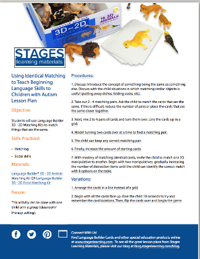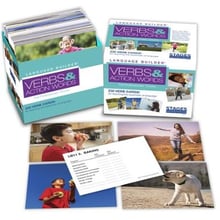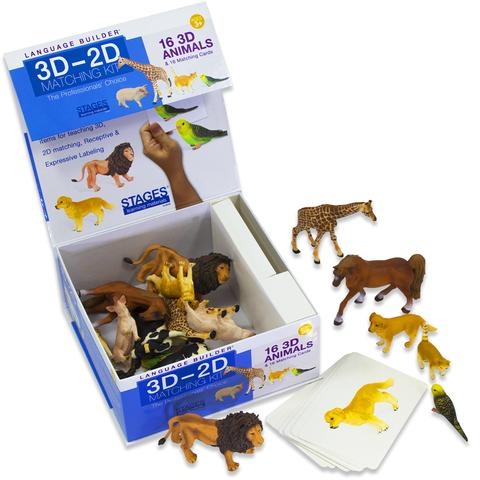Teaching Parts of Speech to Autistic Children: Prepositions, Opposites, Pronouns and Verb Tense
Autistic children frequently have delayed language development. For autistic children who have developed language, understanding or using parts of speech correctly may be difficult. While many children develop language skills incidentally, parts of speech such as prepositions, opposites, pronouns, or verb tenses may be more difficult and require explicit instruction. Understanding parts of speech is important because it shows how words relate to one another in a meaningful way and allows for clear communication.

Download FREE Lesson Plan Using Identical Matching for Beginning Language Skills
Many autistic children echo or script. Children who echo repeat what they heard. Children who script memorize things they have previously heard. Echoing and scripting become powerful platforms for children to develop language but may impair their ability to identify the correct part of speech they should be using.
Teaching children these building blocks of sentences allows them to flourish as speakers and communicators, helping them to gain more independence and confidence. Many types of tools can be used to bolster a child’s language skills. STAGES® Learning offers a collection of research-based Language Builder cards to help guide your child’s learning and language development.
Identifying Prepositions
Prepositions are words that express the location of a noun in relation to another word. Some examples of prepositions include: above, across, against, along, among, around, at, before, behind, below, beneath, beside, between, by, down, from, in, into, near, of, off, on, to, toward, under, upon, with, within, etc.
In teaching how to identify prepositions, students will learn to receptively identify and expressively label a variety of prepositions. Receptively identifying means the student can respond when a teacher asks, e.g. show me “on” (“Which card is on the table?). Expressively labeling means the student can answer a question, e.g. “Where is the card?,” and respond, “It is on the table.”
Prepositions can be difficult for children to learn, as the same object can be described in relation to so many other things around. For example, if you ask a child, “Where is the cup?” They may have multiple answers, including “On the table,” “Next to the phone,” “Near the plate,” and so on. While children are beginning to learn how to use prepositions in their language, it is important and helpful to create a space with little distraction so they can begin to clearly understand prepositions. It may be helpful to use a large cardboard box to seclude objects that you are using and create a focused space for children to explore. It may also be helpful to use movement to help a child learn. Bring them to their favorite playground and practice running next to the slide, under the monkey bars, or on top of the platform!
The great thing about prepositions is that there are endless opportunities throughout the day to practice them with your child. Within the home, (“Where is the dog?” “On the couch.”) or in the community (“Where is the shoe store?” “The shoe store is next to the grocery store.”)
For this activity, the Language Builder: 3D-2D Matching Kits will be useful.

Language Builder: 3D - 2D Animal Matching Kit |
Choose a reference object the student can use, such as a chair, table, box, shelf, or some other object that is nearby.
Phase 1: Identification of 3D Object Positioning
- Place two target objects in reference to the reference object. (For example, place a toy on the table and a toy next to the table.
- Give the instruction, “Show me on” or “Touch next to.”
- Allow the student time to select the object in the requested position(s).
- Prompt if necessary.
- When the student can identify the prepositions receptively, do the activity expressively if possible. For example, point to an object and ask the student, “Where is the toy.” Wait for the student to say the correct position: “In” or “The toy is in the box.”
Phase 2: Identification of Preposition Photos
- Place one preposition card in front of the student.
- Give the instruction, “Show me next to,” “Point to under,” or “Find between.”
- Allow the student time to select the correct preposition card.
- Prompt if necessary.
- When the student can identify the preposition photos receptively, do the activity expressively (i.e. ask the student to say the word). For example, show the student a photo, and ask, “Where is the toy?” Wait for the student to say the correct position: “Under” or “The toy is under the table.”
Opposites
Opposites are when two words have different or reverse meanings. Some examples of opposites include: big/small, clean/dirty, empty/full, good/bad, more/less, fast/slow, happy/sad, quiet/loud, and so on.
Learning opposites is an important skill and will improve your child’s ability to communicate and include a greater amount of detail in the language they use. Being able to describe two things in comparison (ex. the empty cup versus the full cup) will also help improve understanding of specific concepts.
Like prepositions, there are so many natural opportunities to practice opposites throughout the day. For example, identifying, “It’s hot outside! What is the opposite of hot?,” allowing your child the opportunity to identify “Cold!” These interactions can be made into fun, educational games throughout the day!
In teaching opposites, students will learn how to receptively identify and expressively label a variety of opposite things.
For this activity, use physical objects that are opposites.
Phase 1: Select between 2 opposite things using physical objects.
- Sit facing the student. Make sure you have their attention.
- Place two identical objects in front of the student that demonstrate opposite states. For example, a wet towel and a dry towel.
- Ask the student, “Which one is wet?”
- Prompt if necessary,
- Allow the student time to select the correct object. Reinforce the student!
 Phase 2: Select between 2 opposite things using photo cards.
Phase 2: Select between 2 opposite things using photo cards.
- Sit facing the student. Make sure you have their attention.
- Place a pair of opposite cards in front of the student. Start with an opposite pair that is easy to identify in photo cards, such as clean and dirty.
- Ask the student, “Which one is clean?”
- Prompt if necessary.
- Allow the student time to select the correct card. Reinforce the student!
Understanding Pronouns
Pronouns are words that replace nouns. For example, I, me, she, we, they, who, that, yours, his, her, it,
Pronouns can be difficult to learn because different pronouns can essentially hold the same general meaning (ex. “I,” “My,” “Me”). Likewise, pronoun use can be too vague (ex. “She wants to play.” “Who is ‘she’?”). Therefore, as you begin to teach pronouns, it is important to use the person’s name in addition to their pronoun (ex. “Jane wants to play with you. She wants to play soccer with you”).
In teaching pronouns, the student will learn to appropriately use various types of pronouns in a sentence.
 For this activity, the Language Builder Card Sets provide photos that can be used to teach various pronouns and can be helpful.
For this activity, the Language Builder Card Sets provide photos that can be used to teach various pronouns and can be helpful.
- Sit facing the student. Make sure you have their attention.
- Pull cards from any of the Language Builder Sets that can be used to illustrate the pronouns you are working on. For example, "She is running," "He is a teacher," or "She is smiling."
- Ask a question that is referencing a noun: “What is the girl doing?”
- Require the student to respond using the correct pronoun: “She is running.”
- Prompt as necessary.
- Reinforce the student using the pronoun in your reinforcement: “That’s right! She is running!”
Some autistic children may echo speech, which often leads to pronoun confusion. For example, if the child is asked, “Do you want an apple?” They may answer with, “You want an apple.” This is known as “pronoun reversal.” Eliminating pronouns in speech altogether in the beginning may help. For example, instead of “Do you want an apple?” ask, “Want an apple?” which prompts a simple ‘yes’ or ‘no,’ and eliminates the opportunity for children to echo the incorrect pronoun. Once the student is exposed to lessons surrounding pronouns and begins to learn them, they can be introduced into regular, everyday speech, simply, at first. As the child is beginning to learn the concept, using simple pronoun commands such as, “I do, you do” or “My turn, your turn” is a clear way to model the different pronouns used in those situations.
Past & Present Verb Tenses
Verbs are words that show action. Past tense verbs show that an action took place. Past tense verbs often end in -ed. Present tense verbs show that the action is going on now. Present tense verbs often end in -s, -es, or -ing.
Understanding verb tense is important because it creates a connection between time, giving clearer meaning to what is being said.

|
In learning past and present verb tenses, students will learn to correctly use regular and irregular past tense verbs and distinguish them from present tense verbs.
For this activity, the Language Builder Verbs & Action Words Cards will be helpful.
- Sit facing the student. Make sure you have their attention.
- Pull target cards from Language Builder: Verbs & Action Words Cards.
- Choose one action to begin with.
- Place one card in front of the student as appropriate.
- Ask the student, “What are they doing?”
- Prompt if necessary.
- Wait for the student to identify the correct verb: “They are clapping.”
- Reinforce the student!
- Ask the student, “What did they do?”
- Prompt if necessary.
- Wait for the student to identify the correct past tense verb: “They clapped.”
- Reinforce the student.
When the student can correctly answer present tense and past tense questions about the verb several times in a row, introduce “distractors.” Teaching action verbs is a wonderful opportunity to incorporate multisensory learning. Do the action as you teach our child! As the child progresses, begin to include irregular verbs.
Communication is one of the most powerful tools humans have. For autistic children who may experience communication and language development delays, supporting speech development and teaching parts of speech is important. Language is complex and there are plenty of irregular words, so it’s important not to feel discouraged or overwhelm your child with too much information all at once. Language development happens best through repetition and exposure, and there are many opportunities to practice!
This article was based on the following research:
https://www.marybarbera.com/teaching-pronouns-kids-with-autism-and-avoiding-pronoun-reversal/
https://theautismhelper.com/more-preposition-adapted-books/
https://journals.sagepub.com/doi/abs/10.1177/1053451215585807?journalCode=iscc
https://www.guruparents.com/teaching-opposites/
https://www.thoughtco.com/aba-teaching-verbs-children-with-autism-3110378






